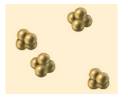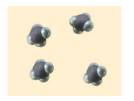
Bundle: Introductory Chemistry: An Active Learning Approach, 6th + OWLv2, 1 term (6 months) Printed Access Card
6th Edition
ISBN: 9781305717367
Author: Mark S. Cracolice, Ed Peters
Publisher: Cengage Learning
expand_more
expand_more
format_list_bulleted
Concept explainers
Textbook Question
Chapter 2, Problem 2.7TC
Which of the following are compounds, and which are elements?
a) Na2S
b) Br2
c) Potassium hydroxide
d) Fluorine
e) Compound or element

f) Compound or element

Expert Solution & Answer
Trending nowThis is a popular solution!

Students have asked these similar questions
4) Answer the following exercise with curved arrows indicating who is a
nucleophile or Who is the electrophile?
2.44 Predict the structure of the product formed in the reaction of the organic base
pyridine with the organic acid acetic acid, and use curved arrows to indicate
the direction of electron flow.
7
H3C
OH
N
Pyridine
Acetic acid
Using the data provided please help me answer this question.
Determine the concentration of the iron(Ill) salicylate in the unknown directly from to graph and from the best fit trend-line (least squares analysis) of the graph that yielded a straight line.
Please help me figure out what the slope is and how to calculate the half life Using the data provided.
Chapter 2 Solutions
Bundle: Introductory Chemistry: An Active Learning Approach, 6th + OWLv2, 1 term (6 months) Printed Access Card
Ch. 2 - Consider the photograph and illustrations of table...Ch. 2 - In the left box, draw a particulate-level...Ch. 2 - Classify the following changes as chemical C or...Ch. 2 - Specific gravity is a physical property. Beakers...Ch. 2 - Classify the following as homogenous or...Ch. 2 - Table salt from the beaker on the left in the...Ch. 2 - Which of the following are compounds, and which...Ch. 2 - Prob. 2.8TCCh. 2 - Identify the net electrical force-attraction,...Ch. 2 - aIs the process of boiling water exothermic or...
Ch. 2 - In everyday language, the term conserve usually...Ch. 2 - Write a brief description of the relationships...Ch. 2 - Write a brief description of the relationships...Ch. 2 - Prob. 3CLECh. 2 - Write a brief description of the relationships...Ch. 2 - Prob. 5CLECh. 2 - Prob. 6CLECh. 2 - Prob. 1ECh. 2 - Classify each of the following as macroscopic,...Ch. 2 - Suggest a reason for studying matter at the...Ch. 2 - How does a chemist think about particles that are...Ch. 2 - Using spheres to represent individual atoms,...Ch. 2 - Describe a piece of ice at the particulate level....Ch. 2 - 7.The word pour is commonly used in reference to...Ch. 2 - Prob. 8ECh. 2 - Which of the three states of matter is most easily...Ch. 2 - Compare the volumes occupied by the same sample of...Ch. 2 - Classify each of the following properties as...Ch. 2 - Classify the italicized property as chemical or...Ch. 2 - Which among the following are physical changes? a...Ch. 2 - Classify each of the following changes as chemical...Ch. 2 - Is the change illustrated below a physical change...Ch. 2 - Is the change in the illustration below a physical...Ch. 2 - Diamonds and graphite are two forms of carbon....Ch. 2 - Aspirin is a pure substance. If you had the choice...Ch. 2 - The substance in the glass below is from a kitchen...Ch. 2 - Are the contents of the bottle in the picture...Ch. 2 - Which of the following particulate illustrations...Ch. 2 - Which of the following particulate illustrations...Ch. 2 - Which of the following are pure substances and...Ch. 2 - Which of the substances below are pure and which...Ch. 2 - Apart from food, list five things in your home...Ch. 2 - Can the terms homogeneous and heterogeneous be...Ch. 2 - Which items in the following list are...Ch. 2 - Classify each of the following mixtures as either...Ch. 2 - Some ice cubes are homogeneous and some are...Ch. 2 - The freshly polished brass cylinder in the picture...Ch. 2 - Draw a particulate-level sketch of a heterogeneous...Ch. 2 - Draw a particulate-level sketch of a homogeneous...Ch. 2 - Suppose someone emptied ball bearings into a...Ch. 2 - Suggest at least two ways to separate ball...Ch. 2 - Prob. 35ECh. 2 - You receive a mixture of table salt and sand and...Ch. 2 - Classify the following as compounds or elements: a...Ch. 2 - Classify each of the following pure substances as...Ch. 2 - Which of the following are elements, and which are...Ch. 2 - Classify each of the following pure substances as...Ch. 2 - Classify each substance in the illustrations below...Ch. 2 - Does each of the particulate-level models below...Ch. 2 - a Which of the following substances would you...Ch. 2 - a Which of the following substances would you...Ch. 2 - Metal A dissolves in nitric acid solution. You can...Ch. 2 - A white, crystalline material that looks like...Ch. 2 - Questions 47 and 48: Samples of matter may be...Ch. 2 - Questions 47 and 48: Samples of matter may be...Ch. 2 - What is the main difference between electrostatic...Ch. 2 - Identify the net electrostatic force attraction,...Ch. 2 - Identify the reactants and products in the...Ch. 2 - In the following equation for a chemical reaction,...Ch. 2 - In the equation Ni+Cu(NO3)2Ni(NO3)2+Cu, which of...Ch. 2 - Write the formulas of the elements that are...Ch. 2 - Prob. 55ECh. 2 - Classify each of the following changes as...Ch. 2 - As a child plays on a swing, at what point in her...Ch. 2 - A bicycle accelerates from 5 miles per hour to 15...Ch. 2 - After solid limestone is heated, the rock that...Ch. 2 - Before electronic flashes were commonly used in...Ch. 2 - The photograph below shows a beaker of water and a...Ch. 2 - Prob. 62ECh. 2 - Prob. 63ECh. 2 - Prob. 64ECh. 2 - Distinguish precisely and in scientific terms the...Ch. 2 - Prob. 66ECh. 2 - A natural-food store advertises that no chemicals...Ch. 2 - Prob. 68ECh. 2 - Name some pure substances you have used today.Ch. 2 - How many homogeneous substances can you reach...Ch. 2 - Which of the following can be pure substances:...Ch. 2 - Can you have a mixture of two elements as well as...Ch. 2 - Can you have more than one compound made of the...Ch. 2 - Rainwater comes from the oceans. Is rainwater more...Ch. 2 - Prob. 75ECh. 2 - Prob. 76ECh. 2 - Consider the sample of matter in the illustration...Ch. 2 - A particulate-level illustration of the reaction...Ch. 2 - Prob. 79ECh. 2 - Prob. 80ECh. 2 - Prob. 81ECh. 2 - Prob. 82ECh. 2 - Particles in the illustration below undergo a...Ch. 2 - Prob. 84E
Knowledge Booster
Learn more about
Need a deep-dive on the concept behind this application? Look no further. Learn more about this topic, chemistry and related others by exploring similar questions and additional content below.Similar questions
- Curved arrows are used to illustrate the flow of electrons. Follow the curved arrows and draw the structure of the missing reactants, intermediates, or products in the following mechanism. Include all lone pairs. Ignore stereochemistry. Ignore inorganic byproducts. H Br2 (1 equiv) H- Select to Draw Starting Alkene Draw Major Product I I H2O 四: ⑦.. Q Draw Major Charged Intermediate Iarrow_forwardNH (aq)+CNO (aq) → CO(NH2)2(s) Experiment [NH4] (M) [CNO] (M) Initial rate (M/s) 1 0.014 0.02 0.002 23 0.028 0.02 0.008 0.014 0.01 0.001 Calculate the rate contant for this reaction using the data provided in the table.arrow_forward2CIO2 + 20H-1 CIO31 + CIO2 + H2O Experiment [CIO2], M [OH-1], M 1 0.0500 0.100 23 2 0.100 0.100 3 0.100 0.0500 Initial Rate, M/s 0.0575 0.230 0.115 ... Given this date, calculate the overall order of this reaction.arrow_forward
- 2 3 .(be)_[Ɔ+(be)_OI ← (b²)_IƆO+ (be)_I Experiment [1-] M 0.005 [OCI-] 0.005 Initial Rate M/min 0.000275 0.0025 0.005 0.000138 0.0025 0.0025 0.000069 4 0.0025 0.0025 0.000140 Calculate the rate constant of this reaction using the table data.arrow_forward1 2 3 4 I(aq) +OCl(aq) → IO¯¯(aq) + Cl¯(aq) Experiment [I-] M 0.005 [OCI-] 0.005 Initial Rate M/min 0.000275 0.0025 0.005 0.000138 0.0025 0.0025 Calculate the overall order of this reaction using the table data. 0.0025 0.000069 0.0025 0.000140arrow_forwardH2O2(aq) +3 I¯(aq) +2 H+(aq) → 13(aq) +2 H₂O(l)· ••• Experiment [H2 O2]o (M) [I]o (M) [H+]。 (M) Initial rate (M/s) 1 0.15 0.15 0.05 0.00012 234 0.15 0.3 0.05 0.00024 0.3 0.15 0.05 0.00024 0.15 0.15 0.1 0.00048 Calculate the overall order of this reaction using the table data.arrow_forward
- The U. S. Environmental Protection Agency (EPA) sets limits on healthful levels of air pollutants. The maximum level that the EPA considers safe for lead air pollution is 1.5 μg/m³ Part A If your lungs were filled with air containing this level of lead, how many lead atoms would be in your lungs? (Assume a total lung volume of 5.40 L.) ΜΕ ΑΣΦ = 2.35 1013 ? atoms ! Check your rounding. Your final answer should be rounded to 2 significant figures in the last step. No credit lost. Try again.arrow_forwardY= - 0.039 (14.01) + 0.7949arrow_forwardSuppose 1.76 g of magnesium acetate (Mg (CH3CO2)2) are dissolved in 140. mL of water. Find the composition of the resulting electrolyte solution. In particular, list the chemical symbols (including any charge) of each dissolved ion in the table below. List only one ion per row. mEq Then, calculate the concentration of each ion in dwrite the concentration in the second column of each row. Be sure you round your answers to the L correct number of significant digits. ion Add Row mEq L x 5arrow_forward
- A pdf file of your hand drawn, stepwise mechanisms for the reactions. For each reaction in the assignment, you must write each mechanism three times (there are 10 reactions, so 30 mechanisms). (A) do the work on a tablet and save as a pdf., it is expected to write each mechanism out and NOT copy and paste the mechanism after writing it just once. Everything should be drawn out stepwise and every bond that is formed and broken in the process of the reaction, and is expected to see all relevant lone pair electrons and curved arrows.arrow_forwardNonearrow_forwardNonearrow_forward
arrow_back_ios
SEE MORE QUESTIONS
arrow_forward_ios
Recommended textbooks for you
 Introductory Chemistry: An Active Learning Approa...ChemistryISBN:9781305079250Author:Mark S. Cracolice, Ed PetersPublisher:Cengage LearningChemistry: Matter and ChangeChemistryISBN:9780078746376Author:Dinah Zike, Laurel Dingrando, Nicholas Hainen, Cheryl WistromPublisher:Glencoe/McGraw-Hill School Pub Co
Introductory Chemistry: An Active Learning Approa...ChemistryISBN:9781305079250Author:Mark S. Cracolice, Ed PetersPublisher:Cengage LearningChemistry: Matter and ChangeChemistryISBN:9780078746376Author:Dinah Zike, Laurel Dingrando, Nicholas Hainen, Cheryl WistromPublisher:Glencoe/McGraw-Hill School Pub Co Chemistry & Chemical ReactivityChemistryISBN:9781133949640Author:John C. Kotz, Paul M. Treichel, John Townsend, David TreichelPublisher:Cengage Learning
Chemistry & Chemical ReactivityChemistryISBN:9781133949640Author:John C. Kotz, Paul M. Treichel, John Townsend, David TreichelPublisher:Cengage Learning Chemistry by OpenStax (2015-05-04)ChemistryISBN:9781938168390Author:Klaus Theopold, Richard H Langley, Paul Flowers, William R. Robinson, Mark BlaserPublisher:OpenStax
Chemistry by OpenStax (2015-05-04)ChemistryISBN:9781938168390Author:Klaus Theopold, Richard H Langley, Paul Flowers, William R. Robinson, Mark BlaserPublisher:OpenStax Chemistry: Principles and ReactionsChemistryISBN:9781305079373Author:William L. Masterton, Cecile N. HurleyPublisher:Cengage Learning
Chemistry: Principles and ReactionsChemistryISBN:9781305079373Author:William L. Masterton, Cecile N. HurleyPublisher:Cengage Learning Chemistry: The Molecular ScienceChemistryISBN:9781285199047Author:John W. Moore, Conrad L. StanitskiPublisher:Cengage Learning
Chemistry: The Molecular ScienceChemistryISBN:9781285199047Author:John W. Moore, Conrad L. StanitskiPublisher:Cengage Learning

Introductory Chemistry: An Active Learning Approa...
Chemistry
ISBN:9781305079250
Author:Mark S. Cracolice, Ed Peters
Publisher:Cengage Learning

Chemistry: Matter and Change
Chemistry
ISBN:9780078746376
Author:Dinah Zike, Laurel Dingrando, Nicholas Hainen, Cheryl Wistrom
Publisher:Glencoe/McGraw-Hill School Pub Co

Chemistry & Chemical Reactivity
Chemistry
ISBN:9781133949640
Author:John C. Kotz, Paul M. Treichel, John Townsend, David Treichel
Publisher:Cengage Learning

Chemistry by OpenStax (2015-05-04)
Chemistry
ISBN:9781938168390
Author:Klaus Theopold, Richard H Langley, Paul Flowers, William R. Robinson, Mark Blaser
Publisher:OpenStax

Chemistry: Principles and Reactions
Chemistry
ISBN:9781305079373
Author:William L. Masterton, Cecile N. Hurley
Publisher:Cengage Learning

Chemistry: The Molecular Science
Chemistry
ISBN:9781285199047
Author:John W. Moore, Conrad L. Stanitski
Publisher:Cengage Learning
Types of Matter: Elements, Compounds and Mixtures; Author: Professor Dave Explains;https://www.youtube.com/watch?v=dggHWvFJ8Xs;License: Standard YouTube License, CC-BY